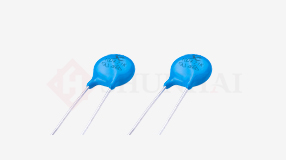Varistors are a type of voltage limiting protective device, whose core function is to quickly conduct when overvoltage occurs through nonlinear volt ampere characteristics, clamp the voltage within a safe range, and protect the downstream circuit. The following is a detailed classification and technical analysis of varistors:

1、 Classified by material type
Zinc oxide varistor (ZnO Varistor)
Material: Mainly composed of zinc oxide (ZnO), doped with metal oxides such as cobalt and manganese.
Characteristics: High nonlinear coefficient (α=30~50), strong flow capacity (up to tens of kiloamperes).
Application: Power surge suppression, lightning protection, motor start-up protection.
Silicon carbide varistor (SiC Varistor)
Material: Sintered from silicon carbide (SiC) powder.
Features: Excellent high-frequency characteristics, suitable for high-voltage pulse scenarios.
Application: High frequency induction heating, pulse power module.
Silicon Varistor
Material: silicon-based semiconductor material.
Characteristic: Good linearity (α ≈ 1), but weak flow capacity.
Application: Precision temperature measurement, linear voltage stabilization circuit.
2、 Classified by structural type
Disc-shaped varistor
Structure: Circular ceramic substrate, surface coated with metal electrodes.
Application: Universal surge protection, such as power adapters and household appliances.
Packaging: Radial lead packaging (such as φ 5mm, φ 10mm).
Circular varistor
Structure: Circular ceramic substrate, suitable for high current scenarios.
Application: Motor start-up protection, high-power power module.
Advantages: Excellent heat dissipation performance, able to withstand transient high currents.
Surface mount varistor (MLV)
Structure: Multi layer ceramic structure, surface mount packaging.
Application: Portable devices, high-density PCBs (such as smartphones, wearable devices).
Packaging: 0402, 0603, 0805, etc.
3、 Classified by purpose type
Varistors for power cords
Function: Suppress power startup surges and lightning induced overvoltage.
Parameters: current carrying capacity (1kA~20kA), response time (<25ns).
Application: Switching power supply, LED driver, industrial equipment.
Varistors for signal lines
Function: Protect high-speed signal interfaces (such as USB, HDMI) from ESD/surge interference.
Parameters: Low capacitance (<10pF), low insertion loss.
Applications: Communication devices, consumer electronics, automotive entertainment systems.
Varistors for lightning protection
Function: Absorb high-energy pulses induced by lightning (such as 10kA or above required for Level I lightning protection).
Parameters: High energy absorption capacity (100J~500J), large-sized packaging (such as 20mm diameter).
Applications: base stations, photovoltaic inverters, outdoor monitoring equipment.
4、 Classified by packaging form
Packaging: Radial leads (such as φ 5mm, φ 10mm), axial leads.
Application: high-power power supply, industrial control cabinet.
Advantages: Good heat dissipation performance, suitable for high current scenarios.
Surface mount varistor (MLV)
Packaging: 0402, 0603, 0805, 1206.
Application: Portable devices, high-density PCBs.
Advantages: Small size, suitable for automated mounting.
Specially packaged varistor
Example: Varistors with heat sinks (for high-power scenarios), waterproof packaging (for outdoor applications).
5、 Typical application scenarios
Consumer Electronics
Examples: power adapter, USB charger, LCD TV.
Selection: Disc shaped varistor with a current carrying capacity of 1kA~3kA.
Industrial control
Examples: PLC, frequency converter, servo drive.
Selection: Circular varistor with a current carrying capacity of 5kA~10kA.
communication devices
Example: Base station power supply, fiber optic module, Ethernet switch.
Selection: Surface mount varistor, low capacitance (<5pF).
Automotive Electronics
Example: ECU, car charger, ADAS sensor.
Selection: Passed AEC-Q200 certification, high temperature resistance (-55 ℃~+150 ℃).
6、 Core steps for selection
Determine the protective voltage
Select the varistor voltage (Vr) based on the operating voltage (VCC) of the protected circuit, usually Vr=1.5 × VCC.
Example: Choose a 300V~470V varistor for a 220V AC circuit.
Evaluate flow capacity
Select the flow capacity (Imax) based on the application scenario:
Power surge: 1kA~5kA (consumer electronics).
Lightning protection: 10kA~20kA (industrial/communication).
Motor start-up: 5kA~10kA (industrial control).
Match signal rate
High speed interfaces (such as USB 3.0, HDMI 2.1) require the selection of ultra-low capacitance models (<5pF).
Formula: The signal attenuation caused by capacitance Δ V=I × C × Δ t, ensuring that Δ V<5% × Vswing.
Thermal Design and Reliability
Calculate energy dissipation: E=Vclamp × Ipeak × tpulse, ensuring that it is lower than the rated energy absorption capacity of the varistor.
Choose certified models (such as UL, VDE, AEC-Q200).
